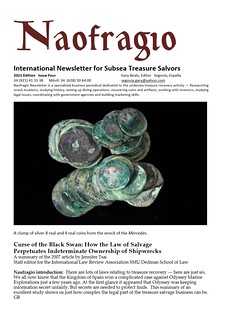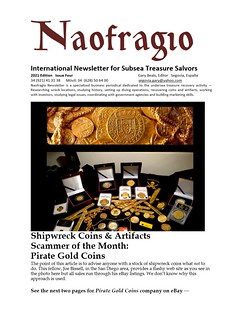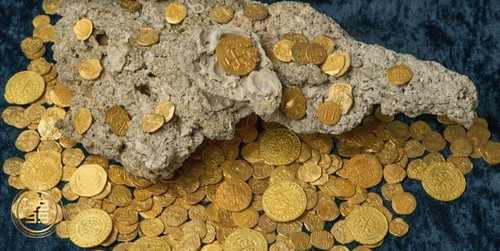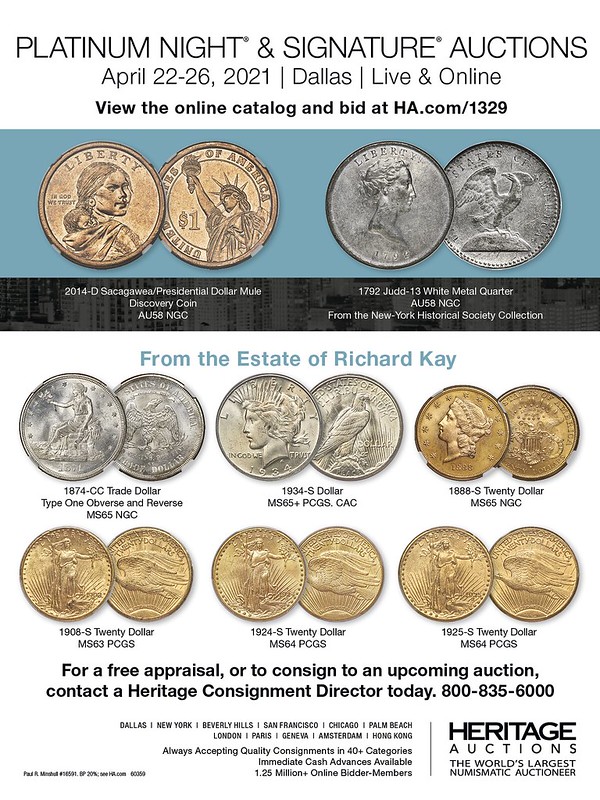
PREV ARTICLE
NEXT ARTICLE
FULL ISSUE
PREV FULL ISSUE
NEW PERIODICAL: THE NAOFRAGIO NEWSLETTERGary Beals of Segovia Spain recently launched a new publication on shipwreck coins. Naofragio is an international newsletter for subsea treasure salvors. He provided this great introduction for E-Sylum readers. Thanks! -Editor
Tons of gold & silver coins are awaiting collectors
as we enter the golden age of shipwreck recovery Thousands of coins are missing from our collections. And hundreds of tons of gold coins, and thousands of tons of silver coins will be recovered from the world's oceans in the next few years. The result should be more affordable scarce coins, each with a fascinating story to tell of its journey from a sunken galleon into a collector's hands. Simple ‘supply and demand' theories about what will occur in the years ahead is not the answer. Could the huge addition of coins create thousands of type set collectors of Colonial Spanish American coins? Some of the coins collectors are missing in their collections are on the bottom of the world's oceans. Storms, earthquakes, crime, navigational errors, and explosions aboard ships over the last four centuries caused this. That historical treasure turns out to be billions of dollars worth of gold and silver coins hidden under sand, mud and coral heads. We can now move past the daydreams and endless chats about how much was lost at sea. We can realistically discuss what might be found. Today all the elements of recovering coins from wrecks are in place. High technology supported underwater equipment has proven itself. Far more serious historical research on treasure wrecks is now being done as the first step in a new recovery process. Governments have become more cooperative about recovering and displaying lost history. There is now a better understanding of the important role archeologists pay in uncovering and studying shipwrecks. And coin collectors are enthusiastic about a wide range of numismatic items coming on the market without overpriced hype. We all were impressed with the amazing scientific and industrial techniques used to find and bring up the thousands of gold coins and ingots from the SS Central America — and that was 36 years ago. Think about the mobile phone and television set you owned in 1985 and the ones you have now. Improvements like that also taken place in the technology of treasure search and recovery on the world's seabeds. You paid much less for the phone and television you have now than the ones you had three decades ago. Correspondingly, you may also pay less for the recovered gold and silver coins in the future. Technology can now bring up more gold and silver from the seabed faster and safer at a lower cost. There will be so many treasure wrecks recovered that the coins we want in our collections may well cost less than the heavily hyped prices of the past. The millions of coins lost in shipwrecks are a small fraction of the amount of wealth that successfully traveled from one point of the globe to another. Documents on sailing ships listed chests of colored gemstones and diamonds, thousands of pearls, magnificent bronze cannons, Ming porcelain and other artifacts made of silver and gold. Wrecks with such treasure are not the subject of this article — unless a few tons of desirable coins are also part of the cargo. We numismatists are tracking only lost coins here — and lots of them. The Spanish mined more than 500,000 ounces of gold and more than five billion troy ounces of silver in the New World according to some studies. The Portuguese discovered that Brazil had tons of gold in the 1700s and set about getting as much of it as possible to Lisbon. There were always official tallies of the treasure as it was moved from one place to another. And the unregistered contraband gold and silver that was mined, smelted, smuggled and also lost makes up another huge number. The spark for this new digital publication came from veteran ocean treasure hunter Bill Warren. Bill and I have been in contact since early this year and his enthusiasm for going after treasures aboard sunken Manila galleons in the Philippines got me fired up. As we talked I wondered how much effort it takes to assemble a wreck recovery team and get underway. As I continue my research on Hispanic coins I am learning more about that process daily. There is a need for an information exchange in the fields surrounding treasure salvors. Divers and salvor firms want to better understand the history of the coins they recover. They should have numismatists handy who can help them with that. On the horizon we can see national governments recognizing that they must partner with trustworthy treasure salvors to harvest the huge wealth just off their shores. I think there is still a misunderstanding about coins as artifacts. A new shipwreck museum in Spain now has the 500,000 bust type 1803 or so 8 reales coins the Odyssey company salvaged and surrendered from the Nuestra Señora de los Mercedes a few years ago. But the government thinks all of the coins should be kept as museum artifacts. Ridiculous — keep 10,000 or 20,000 so to display and sell the rest — they are as common as brown shoes. Use those thousands of ordinary coins to pay for an even better museum. Archeologists are the most patient people in the world, waiting decades to open key digs. But they need to realize silver cannot sit in salt water infinitely. Divers must show they are meticulous in their artifact recovery efforts and willing to be good partners with archeologists and historians. Salvors need to appreciate museum managers and vice-versa. Treasure recovery teams should support local and national museums in the areas where they work. Integrity must prevail. There have been far too many examples of bad behavior in the treasure salvor field in the last few decades. We will be discussing these criminal failings in coming issues. The term ‘mail box' should never appear in the treasure salvor business unless discussing the U.S. Postal Service. Many a dive group has had to wait months or years for government approvals to work a wreck site – and even to be turned down. What are the tricks for speeding up the process without archeological losses? How do we inspire government leaders at various levels to work with us? (And bribes are absolutely out of the question.) We will investigate and write about partnering with governments — even corrupt ones — in the months to come. I want to learn about how treasure recovered from shipwrecks gets to the coin markets. One of my goals would be to help salvors better understand how the numismatic field works. The non-numismatic market could harm things for serious collectors. When someone pays too much for a coin from a shipwreck a new collector is not being created. If there is a mishandling of huge amounts of recovered shipwreck coins the hobby will not grow. This and other aspects of marketing shipwreck coins endangers the need for new collectors in the years ahead. I am eager to talk to all sorts of people in various fields to see what positive changes can accompany the discovery of lost coins. Puffery, hype and silly nonsense surrounds the coins many shipwreck treasure salvors sell to market. It is time to get real just how much extra value — shown as a price — a coin gains coming from the wreck of Nuestra Señora de Quien Sabe. This will be more and more the case and lost wreck after lost wreck has its treasure recovered. The most common form of shipwreck treasure are gold and silver coins. All any national museum needs is a few hundred coins to document a wreck found off its country's coast. All the other thousands can be split between the government and the salvor company. For more information, contact Gary at segovia.gary@yahoo.com . Subscriptions are free for now. -Editor Wayne Homren, Editor The Numismatic Bibliomania Society is a non-profit organization promoting numismatic literature. See our web site at coinbooks.org. To submit items for publication in The E-Sylum, write to the Editor at this address: whomren@gmail.com To subscribe go to: https://my.binhost.com/lists/listinfo/esylum All Rights Reserved. NBS Home Page Contact the NBS webmaster 
|




